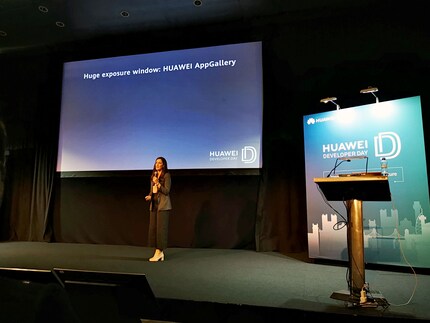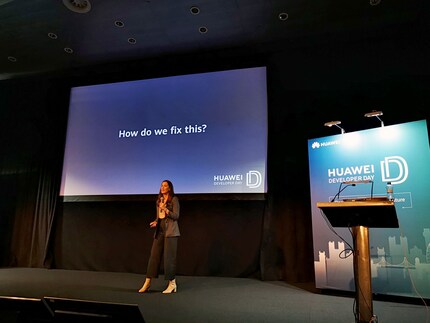
Background information
Huawei without Google Services: A look at the Mate 30 and the future of Android
by Dominik Bärlocher

The Huawei Developer Day in Lisbon raised our hopes. Would they finally say anything about the Google affair? What's in store for the Chinese firm? Huawei gave us a glimpse of their hand, but the biggest questions remain unanswered.
As a smartphone manufacturer, Huawei currently finds itself in a difficult position. Since the USA placed the Chinese company on its so-called «Entity List», US businesses have been forbidden from trading with Huawei. The USA cited security and spying concerns, despite a lack of evidence. «You never know...» seems to be the prevailing theory at the moment, which is why the blacklist exemption licences may be around for a while. However, recent reports indicate that they may be discussed «very shortly».
Huawei has to take action because things have to move on somehow. This is what made the invitation to Web Summit Lisbon impossible to turn down. However, the Web Summit wasn't the highlight: it was the fringe Huawei Developer Day in a small, gloomy room on the exhibition site that drew our attention.
Before the Developer Day, attending journalists and developers knew little: just that Huawei is currently promoting its own app store, the App Gallery. Because the company may no longer use Google Mobile Services, which connects Android to the wider world. Android is still used, however, as it's an open operating system by definition. Android can work without Google Mobile Services, but not particularly well, as they have proven to be essential for many apps over the course of the year.
What’s more, Huawei presented the Huawei Mate 30 Pro a few weeks ago. So there must be huge numbers of the new flagship smartphone in storage somewhere waiting to be shipped. Sales launch: unknown. And not only in Switzerland. Some media outlets have already received devices, digitec among them.
This means that Hauwei has three options when it comes to the Mate 30 Pro, as letting the smartphones gather dust in a warehouse will do no-one any favours. Maybe the phone won't be the top seller that Huawei was hoping for, but lower sales figures surely look better on the books than no sales at all.
The second option seems to fall somewhere between daring and ridiculous. But something else also has to be considered. Huawei doesn't just make smartphones and electronics for consumers. Huawei's 5G infrastructure business is booming. In June 2019, the group announced that two thirds of 5G networks outside of China run on Huawei infrastructure. At the Web Summit, Huawei CEO Guo Ping called for collaboration with Huawei on 5G. The winners of any such arrangements look set to be Huawei partners. Each of these networks is a long-term obligation and Huawei will be pumping in money for years to come. This means that it looks like Huawei is capable of surviving the storm in the smartphone market and that the second option, not launching anymore smartphones, is definitely realistic.
It's understandable that Huawei doesn't want to ruin the customer and fan goodwill it's earned over the years. The group is therefore pursuing a somewhat strange communications strategy: the next steps are hardly saying anything at all, the Mate 30 being postponed indefinitely – but there are unconfirmed rumours of a Christmas launch – and the situation with the USA being either sugarcoated or aggressively ignored. Things are being said to put Huawei in the best possible light, even though the audience knows that, actually, not everything is rosy. Because things aren't good at all.
It can't go on like this.
It wasn't only end clients, journalists and fans that were hoping for new information from Huawei. Developers at the Web Summit were in the same position because they are the ones who will have to programme apps and content for either Android (with or without Google Mobile Services) or HarmonyOS. They need information to work as efficiently and effectively as possible.

Information that Huawei didn't provide at the Developer Day. Instead, there was yet another repeat of the company history and its future. Media representatives were not allowed to ask questions.
This highlighted the event's biggest problem: Huawei told us a lot about nothing instead of telling developers how they should work with HMS and what timescales they should be expecting. First and foremost, end clients would probably like to know when the Mate 30 is going to be launched, so they know how long they'll have to wait. And, above all, will Huawei be working with Google Message Services again as soon as possible?
It would have been good for Huawei to explain why we were actually there.
Huawei wants to invest in developing its own app store. A billion dollars has been mentioned by the China-based company. But the money isn't coming from the Chinese; it's coming from Aspiegel, a Huawei subsidiary in Ireland. Founded by Huawei, the company has been active since 2015 and hosts the details of your Huawei-ID, among other things. Its data centres are located in Germany and are compliant with ISO 27001.
The money is divided into three funds:
A timeline was set out below, but there were no dates. The link to the Aspiegel website aspiegel.com leads to huawei.com.
What now?
The talk from the stage was that apps aren't generally used much at all. A pretty bold statement in a room full of developers. But the Chinese company has a solution for the issue of apps that may have been downloaded but not used: the Huawei Ability Gallery.
If a developer follows the requirements of the Huawei HMS Core Libraries, apps may be able to be fully integrated into the Ability Gallery. This means being integrated in the screen's quick access functions, which you see when you swipe right on a Huawei phone. Let's say you've developed an app that calls taxis, then the Gallery will include a Huawei «Taxi» button. When you click on it, the app will open. It’s meant to be a more inclusive approach for apps.

Among other things, developers have to use Huawei's kits, which are available for free. These kits aren't yet as complete as the ones created by the main competitor, Google, but some others are set to be rolled out by the end of the 2019. They're being documented in the Huawei Codelabs. Features in the Ability Gallery are also set to go beyond the Assistant and the feed screen, anchor themselves in the system and work together.
This clearly shows how far Huawei is still lagging behind and which areas are being rapidly developed. After all, Huawei had never had a reason to provide these kits internationally until now. There's also a good chance that Tencent-developed WeChat is already taking over this function in China. WeChat is an app that can do practically anything and passed the magical one billion users per month mark in 2018. For this reason, Huawei was poorly prepared for the USA situation and is now floundering as a result. The announcement of this deep integration sounds good, exciting and like a lot of fun, but if it hasn’t happened yet, it means nothing for developers.
HMS Core is being expanded in Europe. One feature is so-called Quick Apps. These are nothing other than apps that can be used without having to be installed. Quick Apps use a framework that is integrated in the phone and displays content as if it were in a separate app.
As competition for Google's Instant Apps, Quick Apps should be especially good for games. More performance with less strain on the processor. One of the main early adopters of Quick Apps has been WeChat, where mini programmes are offered as Quick Apps.
The development of Quick Apps is said to be much cheaper and more streamlined for developers than developing a dedicated Android app. Quick Apps are provided in the App Gallery and can be placed on the Home screen like normal apps.
Exciting news: Quick Apps will be important for Huawei Assistant and Huawei Global Search. Other than that, no more details were announced.
However, what is interesting is that Huawei isn't just curtailing its development of the Android platform and software interface EMUI. EMUI is set to become a kind of gateway to the Internet of Things in the near future. Up on the stage, James Lu announced that the big challenge isn't developing apps for a platform, but that there is a reluctance to develop apps for a small market. If there's no ecosystem, hardly anything will be developed for it. That’s a shame, James Lu says.
Huawei's EMUI, which has primarily been a user interface until now, is set to break away from the smartphone with HMS and the connectivity kit and enable access to the Internet of Things. This should then enable you to connect directly to devices with your smartphone.
An example from the stage: if you want to transfer a photo onto your smartphone from your Sony or Canon camera, you’re currently doing something like the following:
The Huawei Share Kit should make this process easier. If you're familiar with Apple's AirDrop, you'll recognise the process:
Photo printing service Cewe is an early adopter of this technology. Is this a campaign where the development fund and its billion-dollar budget has been used? After all, Huawei Share isn't new, but it's virtually unused as no devices really support the technology.
That was just one of the kits that James Lu outlined up on stage. Cast+ or the Cast Kit is set to speed up streaming, the Drive Kit enables integration with cloud services, and so on. All of the kits are available as plugins for the Android Developer Studio.
Four hours. That's how long it took to convey the above information to developers and the media. Four hours of PowerPoint presentations with typos and layout issues. And yet, the whole business with building an ecosystem based on EMUI, the new features and Huawei's plan to attract developers with money are exciting. Very exciting.
If only it weren't for the elephant in the room that all of the officials seemed to be ignoring: what's going to happen with Google? What will become of the Mate 30 Pro? When will Harmony OS be launched? We're still waiting on all of these things. Except for the mention of Harmony. One speaker actually referred to it in the context of an operating system.
But the whole presentation failed to give a reason why developers and users should sign up for the HMS adventure, however interesting and promising it may sound. And this was despite the fact that the whole four-hour event was more of a sales pitch than a source of information for developers.
Journalist. Author. Hacker. A storyteller searching for boundaries, secrets and taboos – putting the world to paper. Not because I can but because I can’t not.